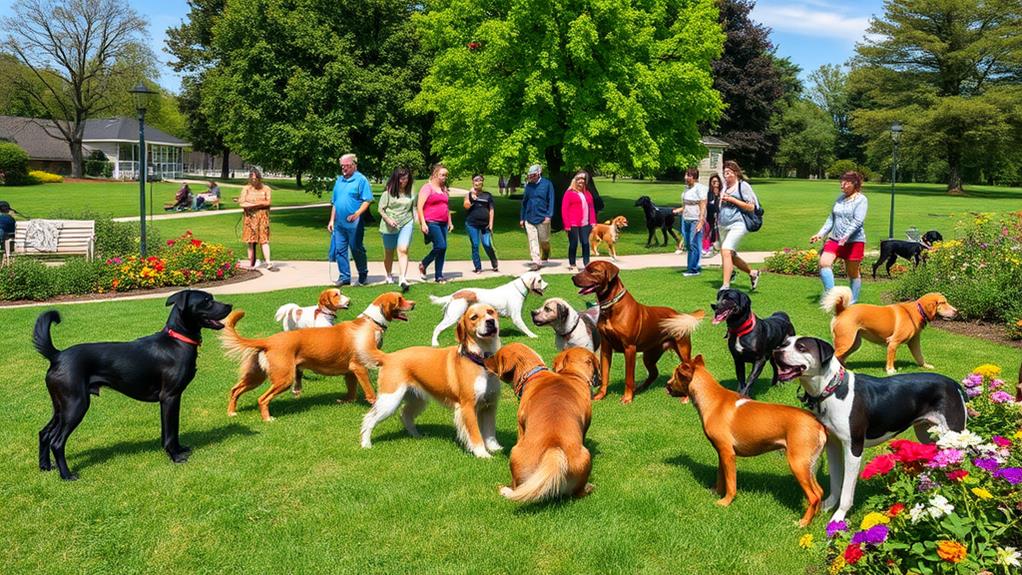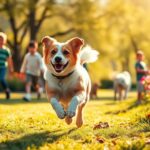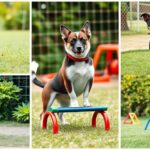When bringing your socialized dog to public spaces, make sure you're well-prepared. Gather essentials like a sturdy leash, water, and treats. Before heading out, assess your dog's mood and consider their comfort level in crowded environments. Keep your dog close with a short leash and stay calm to prevent transferring anxiety. Reward good behavior with treats and watch for signs of stress. Also, allow your dog to sniff new people before interaction but remove them if they seem overwhelmed. There's plenty more to explore about helping your dog thrive in public—stick around to find out!
Understanding Socialization Basics
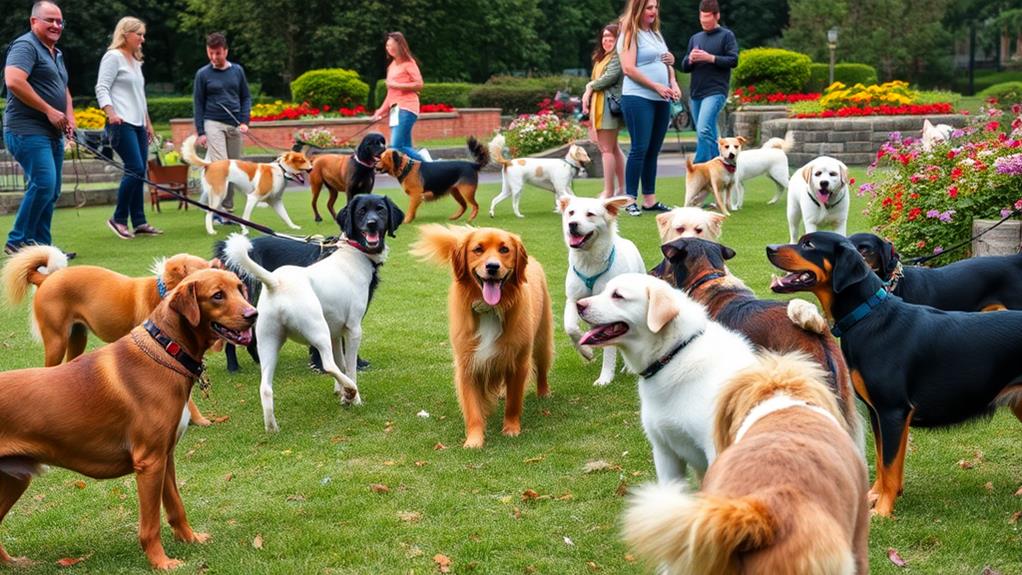
Socializing your dog is essential for their development and well-being. It helps them learn how to interact with other dogs, people, and various environments. When you expose your dog to different experiences, you're building their confidence and reducing anxiety. Start early; puppies are most receptive between three and fourteen weeks. This period is pivotal for shaping their social behavior.
Introduce your dog to various sights, sounds, and smells. Take them to different locations, like parks or bustling streets, to help them adjust to new situations. Use positive reinforcement to encourage good behavior. Reward your dog with treats or praise when they remain calm in unfamiliar settings.
Be mindful of your dog's temperament. Some dogs may be more timid, while others might be overly excited. Adjust your approach based on their reactions, ensuring that socialization remains a positive experience.
Encourage interactions with well-behaved dogs and friendly people. This helps your dog learn appropriate social cues. Remember, socialization is an ongoing process; continue to expose your dog to new experiences throughout their life. This foundation will make outings more enjoyable for both of you as they grow into a well-adjusted companion.
Preparing for Public Outings
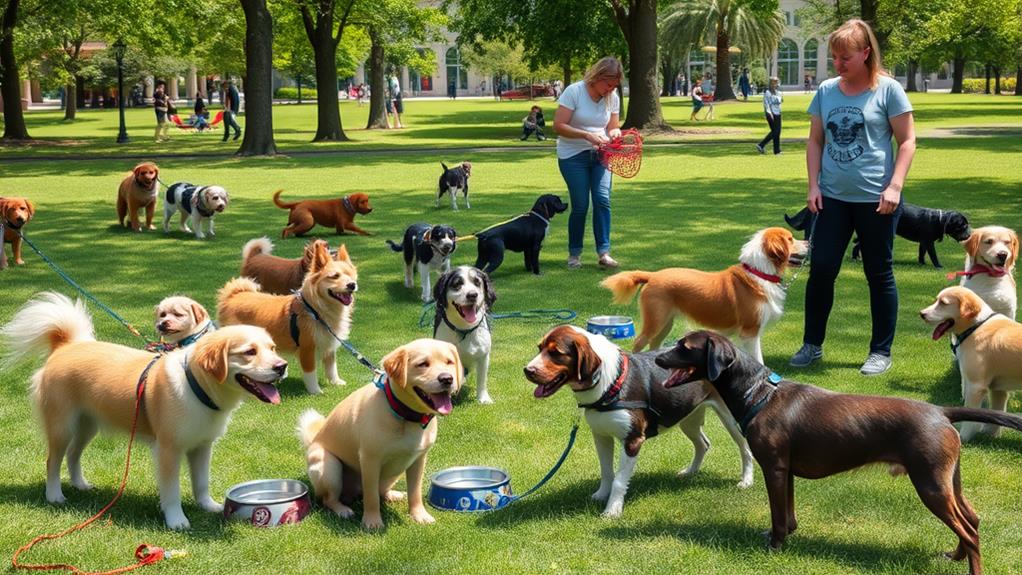
Once your dog has a solid foundation in socialization, it's time to get them ready for public outings. Preparing for these experiences is critical to guarantee you both have a positive time in public spaces.
Start by gathering the right supplies to make your outing smooth and enjoyable. Consider these essentials:
- Leash and Collar: Use a sturdy leash and a comfortable collar or harness to keep your dog secure.
- Water and Bowl: Keep your dog hydrated with a portable water bowl and fresh water, especially on warm days.
- Treats: Bring along some favorite treats to reward good behavior and reinforce training.
- Waste Bags: Always be prepared to clean up after your dog to maintain a clean environment.
Before heading out, take a moment to assess your dog's mood. If they seem anxious or restless, it might be better to wait for another day. Practicing short trips to less crowded areas can help build their confidence. By preparing thoughtfully, you can create enjoyable experiences that reinforce your dog's social skills.
Managing Dog Behavior in Crowds

Maneuvering through crowds with your dog can be both exciting and overwhelming. To guarantee a smooth experience, it's essential to manage your dog's behavior effectively. Start by evaluating your dog's comfort level in crowded environments. If they seem anxious, consider giving them a break in a quieter area before proceeding.
| Tip | Description |
|---|---|
| Stay Calm | Dogs pick up on your emotions, so stay relaxed. |
| Use Short Leashes | Keep your dog close to prevent them from darting. |
| Reward Good Behavior | Treat your dog for staying calm and focused. |
| Avoid Overstimulation | Step back if your dog appears overwhelmed. |
Safety Tips for Public Spaces
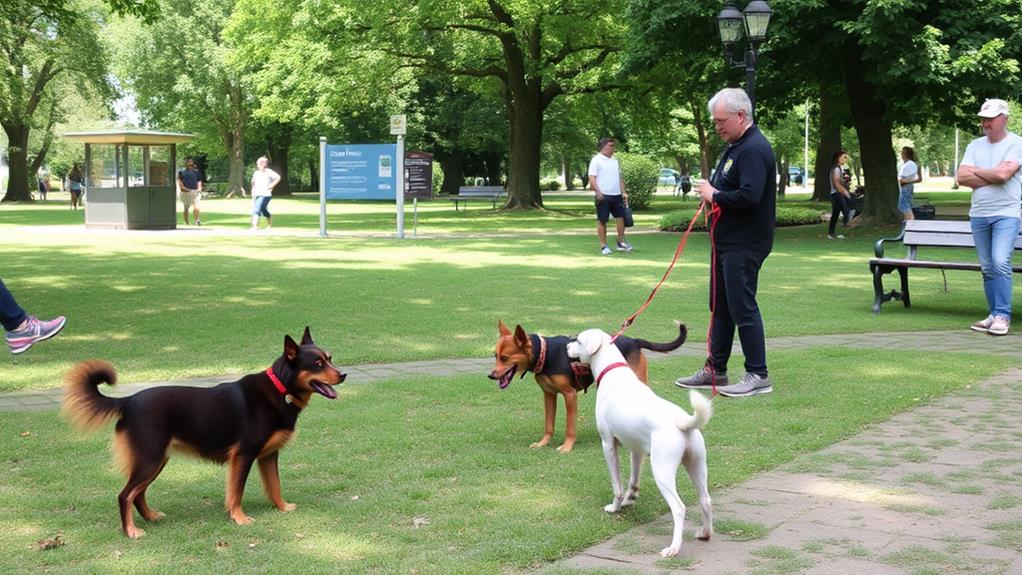
When bringing your dog to public spaces, keeping safety at the forefront is imperative. You want to guarantee a positive experience for both your dog and those around you.
Use a sturdy leash: Always have a secure leash to maintain control, especially in crowded areas. A harness can provide added security.
Be aware of the environment: Keep an eye out for potential hazards like traffic, water, or aggressive dogs. Knowing the surroundings helps you react quickly if needed.
Stay up-to-date on vaccinations: Ensure your dog is fully vaccinated to protect against diseases that can spread in public spaces. Regular vet check-ups are pivotal.
Watch for signs of stress: Pay attention to your dog's body language. If they seem anxious or overwhelmed, it might be time to step away from the crowd or find a quieter spot.
Encouraging Positive Interactions
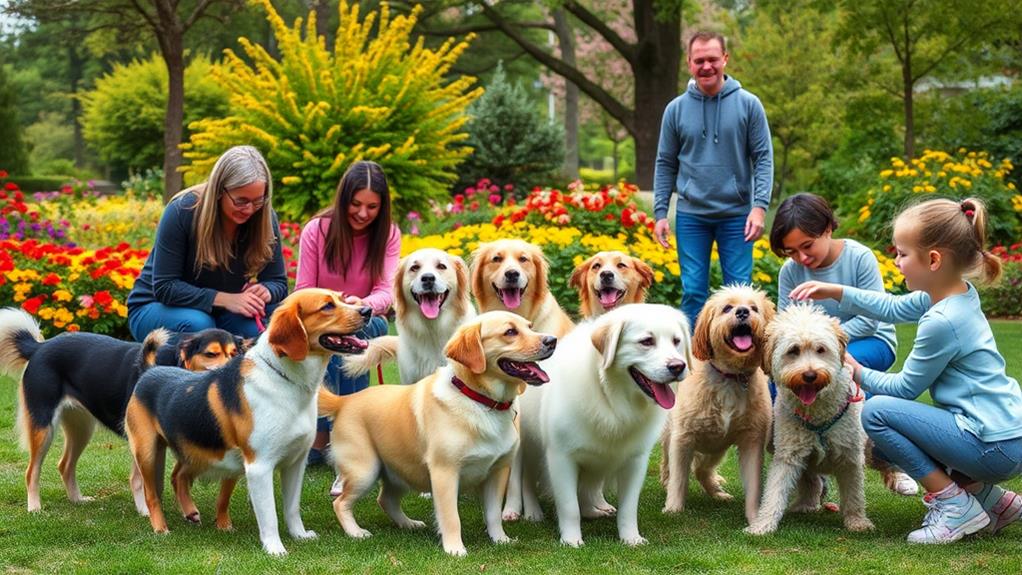
Creating positive interactions between your dog and others in public spaces can greatly enhance their socialization experience. Start by observing your dog's body language and energy levels. If they seem anxious or overwhelmed, it's best to give them some space before introducing them to new people or pets.
When you're ready, approach interactions calmly and confidently. Ask if the other person is comfortable meeting your dog, and encourage them to let your dog sniff their hand before any physical contact. This gives your dog a chance to assess the new person and fosters trust.
Use treats and praise to reward your dog for calm behavior during these interactions. If your dog reacts positively, reinforce that behavior by continuing to socialize them. However, if your dog shows signs of stress or aggression, calmly remove them from the situation to prevent negative experiences.
Frequently Asked Questions
Can Socialized Dogs Still Be Fearful in New Environments?
Yes, socialized dogs can still feel fearful in new environments. Even with socialization, they might encounter unfamiliar sights, sounds, or smells that unsettle them. It's important to observe their behavior and provide reassurance as needed.
How Can I Tell if My Dog Is Overstimulated?
When your dog's like a spinning top, darting around, and their tail's stiff, it's likely overstimulated. Watch for excessive barking or whining; these signals mean it's time to help them unwind and relax.
What Should I Do if My Dog Barks at Strangers?
If your dog barks at strangers, don't panic. Redirect their attention with treats or toys, and practice calming commands. Gradually expose them to new people, rewarding calm behavior to help build their confidence.
Are There Specific Breeds More Suited for Public Spaces?
Certain breeds, like Labradors and Golden Retrievers, tend to adapt well to public spaces due to their friendly nature. However, individual temperament matters, so focus on your dog's personality and training regardless of breed.
How Do I Handle Aggressive Encounters With Other Dogs?
When faced with an aggressive encounter, remember: your reaction shapes the situation. Stay calm, use a firm voice to redirect your dog, and create distance. If necessary, seek help from a professional trainer for guidance.
Conclusion
As you step into bustling parks or vibrant cafés with your socialized dog, remember that every wagging tail and playful bark can spark joy. Embrace the moments of connection—watch as your dog frolics with new friends or snuggles up to a curious child. By preparing wisely and managing their behavior, you create a tapestry of happy memories. So, go ahead, trigger the adventure and let your dog's charm shine brightly in the heart of the community!

